Table of contents:
Quick Stock Overview
Illumina by the numbers.
1. Executive Summary
A brief discussion of Illumina and its potential appeal to value investors.
2. Extended Summary
A more detailed explanation of Illumina’s business and competitive position.
3. The Next Level of Genetics
Why Genomics is the next big thing.
4. The Illumina Revolution
How Illumina makes genomics happens, and its quasi-monopoly over the sector.
5. Illumina’s Future
The growth of existing markets and many new applications.
6. Litigation and Financial Results
Grail botched acquisition, falling stock price, and persistent company quality.
7. Conclusion
Quick Stock Overview
Ticker: ILMN
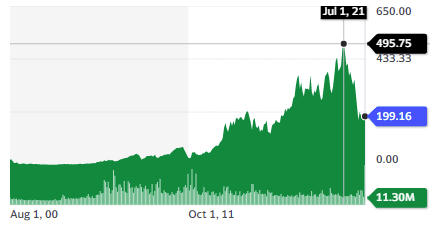
Source: Yahoo Finance
Key Data
| Industry | Healthcare/Diagnostics & Research |
| Market Capitalization ($M) | 31,328 |
| Price to sales | 6.6 |
| Price to Free Cash Flow | 591 |
| Dividend yield | – |
| Sales ($M) | 4,693 |
| Free cash flow/share | 0.34 |
| P/E | – |
1. Executive Summary
A revolution is coming in medicine, unnoticed by the general public. This has to do with the exploration of the genetic makeup of organisms and people: what is called a “genome”.
The cost of sequencing an entire genome has fallen from billions of dollars to a mere $600 in the last decades.
This opens the door to countless new medical and industrial applications for genomics. This new field of science is now a gold rush for pharmaceutical companies, all hoping to use it to solve previously incurable diseases.
One company stands as a quasi-monopoly in providing the tools needed to make it happens.
Illumina is the pioneer and leader of genomics, and build the field from scratch since the late 90s.
The company has a strong substitution cost moat. It also has a powerful flywheel in its business model allowing it to compound on its previous successes.
The company’s stock is nevertheless down 60% from its highs, due to a recent crash in growth tech stocks. In addition, a troubled acquisition of a previous Illumina spin-off has caused uncertainty, litigation, anti-trust investigations, and the first financial losses in 10 years.
These troubles are likely a one-off situation, which has not damaged the long-term prospects of the company.
With Illumina’s price-to-sales ratio at the lowest point in a decade, this might be a great entry point for a high-quality company holding the keystone technology of a quickly growing new sector.
2. Extended Summary: Why Illumina?
The Next Level of Genetics
Mass PCR testing was just a glimpse of the future prevalence of genetic testing in our future life. With genome sequencing becoming cheaper than a smartphone, it will completely change how we live and how we detect and heal diseases.
The Illumina Revolution
Illumina is the Intel of genomics. And like Intel in 1992, it is at the inflection point where its field becomes mainstream. The company benefits from a strong moat (substitution costs) and a high-margin business model with a quasi-monopoly in the sector.
Illumina’s Future
The current business of Illumina in research is still growing quickly. It expects to quadruple its role in cancer diagnostics (currently just 2% of total testing). It will also be at the forefront of opening new markets for genomic testing.
Litigation & Financial Results
The company is struggling to buy back a spun-off company called Grail. The ill-conceived spin-off was a serious blunder, and the acquisition might fail due to anti-trusts regulations. The associated costs have hurt the stock profile and crashed its price.
Still, the core of the company is as solid as ever. No matter what the outcome with Grail is, it should not distract from Illumina’s long-term opportunities and the company’s overall quality.

This report first appeared on Stock Spotlight, our value investing newsletter. Subscribe now to get research, insight, and valuation of some of the most interesting and least-known companies on the market.
Subscribe today to join over 9,000 like-minded investors!
3. The Next Level of Genetics
The Revolution of Genomics
When Covid-19 swept the world, it initially seemed that it would take a long time for a medical response to emerge. But to the public’s surprise, the new virus genes were sequenced in a matter of weeks, and a few weeks later, an mRNA vaccine prototype was ready.
Behind this incredible technical achievement was an extended effort to develop the mRNA vaccine technology. At a deeper level, this made visible a technological revolution that only the specialists were aware of: “genomics”.
Genetics is the science of understanding genes. Genes are made of a sequence of “letter”, molecules that form the genetic code. The full “template” of a gene is deciphered through “sequencing“.
Gene sequencing has enabled medical miracles, like creating a cheap and reliable insulin supply or finding the root cause of genetic diseases. The entirety of the genes of an organism is called a “genome“.
While geneticists usually pay attention to just a few genes, genomics is able to get an exact picture of every single gene all at once. This is like the difference between reading one page of a book compared to an entire library.
When the human genome was “solved” (“sequenced“) for the first time, it took 10 years and almost $3B in costs. In 2001 it still cost $100M to sequence a full human genome.
This cost is now under $600. And it is not a typo, the cost has been divided by more than x100,000.
This is the kind of efficiency increase and cost-saving seen in almost no other industry. The exception is the semiconductor industry, dominated by Moore’s law of doubling chip density every 2 years. While there is no commonly recognized equivalent for genomics, there should be one.
This is the same situation as in the previous report on Applied Material. It can be preferable in a quickly changing and very technical industry to not try to pick THE winner, with the right design, tech, or application. A much safer method is simply to own stock of the company selling irreplaceable tools to the whole industry.
The company this report is analyzing today is the one that made this genomic revolution possible, Illumina.
Everyday Genomics
Even knowing the field well (as I am by training a molecular biologist, a specialist in genetics and genomics), I had not realized how far genomics has gone until I did the research for this report.
I promise I will limit the technical explanation to a minimum. Still, I need to explain why genomics matters.
When studying a whole genome, researchers can acquire the biological equivalent of the blueprint to build a whole airplane.
But with cheap genomics, the same researchers are now like engineers who can obtain blueprints of virtually every airplane ever made. If you wanted to repair a plane or make a better plane, this would turbocharge your capability to do your job.
This is why it matters. Researchers can now compare the whole genomes of tens of thousands of cancer cells and discover exactly what is wrong with them compared to healthy cells, or what could help find them or kill them.
And oncology (cancer) is just one possible application. This technology applies to viruses and bacteria, metabolic diseases, degenerative diseases (Alzeheimer, Parkison), or even improving crops and livestock.
Generalized, cheap, and quick genomics is the wonder tool biologists and doctors have been waiting for 2 centuries.
Mass PCR tests to control a pandemic were just the start.
When I practiced it 14 years ago, genomics was still in its infancy, confined to university labs, and too expensive for any routine use.
It is now reaching the world at large. We can imagine a near future where we would routinely go to the doctor and get a full genetic screening to detect early disease and health risks.
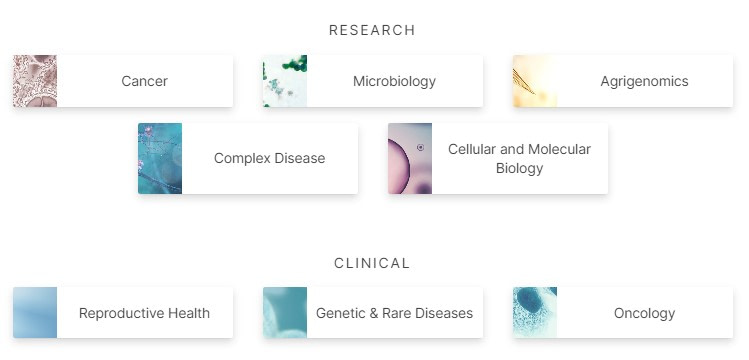
4. The Illumina Revolution
The First Mover Advantage
Illumina was founded in 1998. To keep parallel with the semiconductor industry, Intel was founded in 1968. I firmly believe that Illumina is nowadays in the position that Intel was in 1992, 24 years after its foundation. Costs have gone down so much that the Total Addressable Market (TAM) is ready to explode.
Intel’s products had slowly evolved over decades on the path from Theory & Academia -> Research application -> Industrial Application -> the beginning of a generalized use case. Each of the new steps was triggered by increasing performance and declining costs.
In the early days, no one would imagine computers making their way into our everyday lives. Brilliant and respected scientists in the industry thought it absurd.
There is no reason anyone would want a computer in their home.
Ken Olsen, co-founder of Digital (DEC) (1977)
Similarly, genomics is still a blind spot for investors and most futurists, who are more focused on space exploration, e-commerce, apps, EVs, and semiconductors.
Because of its early place in developing genetics and genomics, Illumina is now the Intel of the field.
Illumina might someday come under pressure from competitors able to mass produce at cheaper costs, as TSMC did to Intel for computer chips. This is a concern for the 2030s, if not the 2040s when genomics become a commodity. For now, Illumina simply dominates the sector.
If I am right, this makes for a highly compelling long-term investment.

The leadership of Illumina gives it a powerful flywheel competitive advantage:
- Being the leader gives it access to more data and cash than its competitors.
- It allows it to reinvest more than anyone into R&D to make better and cheaper products.
- Illumina’s research budget, prominence, and existing technology enable the Company to attract scientific talent.
- Better products reinforce its competitive position. They also grow the overall market.
- A growing market gives Illumina more data and more money than anyone else.
- Rinse and repeat…
On a side note, I must explain that most of Illumina’s progress is built upon the progress of the semiconductor industry. Silicon wafers, lasers, miniature optics, and nano-scale optical detectors are all parts of Illumina’s equipment.
So in a way, genomics can maybe simply be viewed as a new branch of the semiconductor revolution. Further progress in nanotechnology will also boost Illumina’s growth.
Illumina Products
Illumina is in the business of selling gene sequencing machines. They come in various sizes and capacities, from very high-capacity systems for research labs to small sequencers for hospitals.
Illumina is very much a specialty supplier, with “only” 9,100 customers using 21,000 sequencers.
Most of the installed units are older models, with a much smaller capacity than the recently released high-throughput machine. Existing customers are likely to upgrade progressively, according to their equipment budgets.
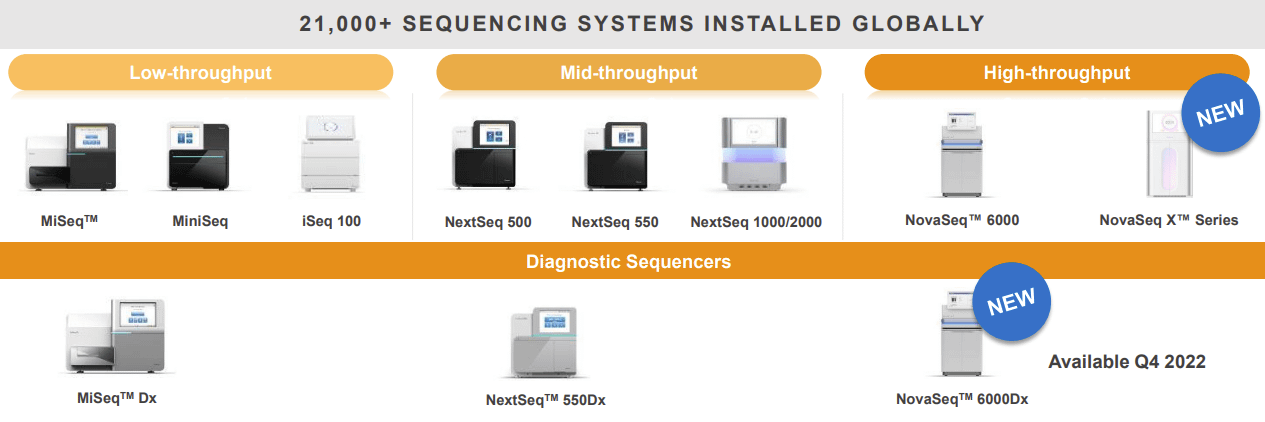
Each of these machines needs a steady supply of consumables provided by Illumina. Most of the chemicals needed are sourced exclusively from Illumina, as they are either too specialized or too important to source from third-party suppliers.
Illumina’s competitive advantage in providing solutions to research problems has been built over the last 10-15 years. I can personally say that modern Illumina machines are what we would have killed to get our hands on in the labs I once worked in. Notably:
- Cheaper sequencing allows for more data with the same (always limited) research budget.
- Automation replaces tedious and back-breaking (literally, I assure you) manual labor, which was wasting the time of Ph.D.-level professionals.
- No cold chain is required, making results more reliable and work simpler.
- Open platforms and standardized data formats allow for the free circulation of knowledge between scientists.
- Quicker analysis reduces the machine’s purchase cost per genome sequenced.
With its newer product NovaSeq X (shipping from 2023), Illumina accelerates the switch to NGS (Next Generation Sequencing). Each machine costs from $985,000 to $1.25M. That’s not cheap, but it’s well within the equipment budget of most major hospitals and universities.
I promised to not dwell too much in technical detail, but if you are interested, you can see in this article, how NGS can, for example, be used to determine why some people are more susceptible to COVID than others.
The price decrease brought by NovaSeq X is expected to add several digits to the total volume of genetic data available to biologists and doctors.

Illumina’s Business Overview
Most of the company revenues do not come from selling machines but from selling consumables. Think of it as the inkjet printer business model. You sell the machine at a relatively low cost, but then make money for years selling the consumables.
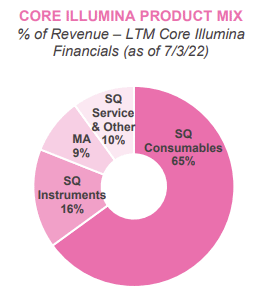
I mentioned the 9,100 customers, but it is also worth mentioning that the customer count has grown 45% since 2019.
The number of installed sequencing machines has more than doubled since 2016, with part of it coming from more growth in medical applications than research.
The installed base makes for a very strong moat, making a substitution with another supplier unlikely for multiple reasons:
- Even with automation, this is still a very technical product and requires significant training for users to learn how to use it best.
- Previous research data or therapeutic tests will have been validated on Illumina machines. Any change in equipment would require extensive re-testing and re-calibrating of existing protocols.
- Illumina machines will work better with or require Illumina consumables, making a substitution for this revenue stream close to impossible.
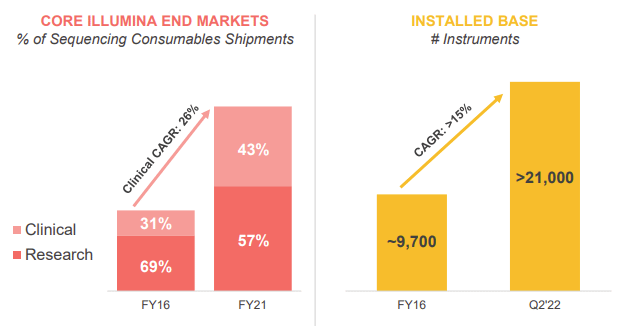
The gross margin is very high, at 60%-70%. Of course, the company spends a lot in R&D to stay on top, reduce sequencing prices and grow the market. If it had to, though, it could cut R&D spending and stay profitable thanks to the very high margins on consumables. This is a very recession-proof type of business model.
I mentioned how Illumina is the leader in the sector. The only serious competitor is PacBio (Pacific Biosciences of California).
PacBio product’s performances are relatively similar to Illumina, but the company is overall much smaller: only $130M in revenues in 2021, compared to Illumina’s $4.5B.

Based on the size difference and market penetration, PacBio does not seem like a very dangerous competitor for Illumina.
I actually appreciate that this is not a pure monopoly situation, as this should keep Illumina from getting complacent. For example, Illumina has the highest R&D spending in the industry, as a percentage of its revenues. Since its revenues are also the highest in the industry, that puts its total R&D spending far above any competitor.
Illumina systems are open, and compatible with tons of other solutions and technologies used by researchers. This allows for a new approach to research and diagnostic called “multiomic”. This stand for the integrated analysis of all the “-omic” at once (genomics, transcriptomic, proteomic, metabolomic, etc…).
Over time (1-2 decades), I would not be surprised to see Illumina turn into a “biology/genomics” platform company, making possible the integration of an exponential quantity of health and biological data.
This is similar to the way companies like Microsoft, Apple, and Google, but also Samsung, Intel, and TSMC benefited from the abundance of software, apps, and SaaS products made by other companies.
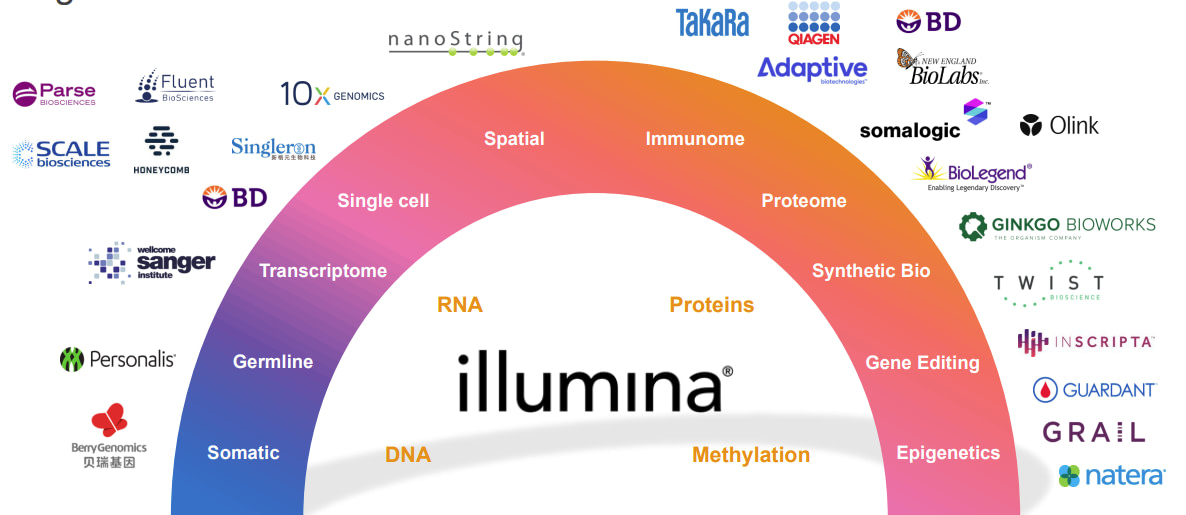
5. Illumina’s Future
Quickly Growing Existing Markets
The market for Next Generation Sequencing (NGS) is quickly growing, as it is replacing older, more expensive, or less reliable biochemical testing methods.
In fundamental research, 26% of the market already uses NGS, which is expected to grow to 34% by 2027.
The largest growth opportunity is in cancer testing, a $78B market, more than half of the total potential market for NGS, and triple the size of the research market.
Only 2% of the current cancer testing market is using NGS, and this is expected to quadruple by 2027. Even then, a mere 8% leaves a long way to go before most cancer testing is done through genomics.
The existing markets outside of pure research are very far from saturated and leave Illumina with a decades-long growth runway in its core markets.
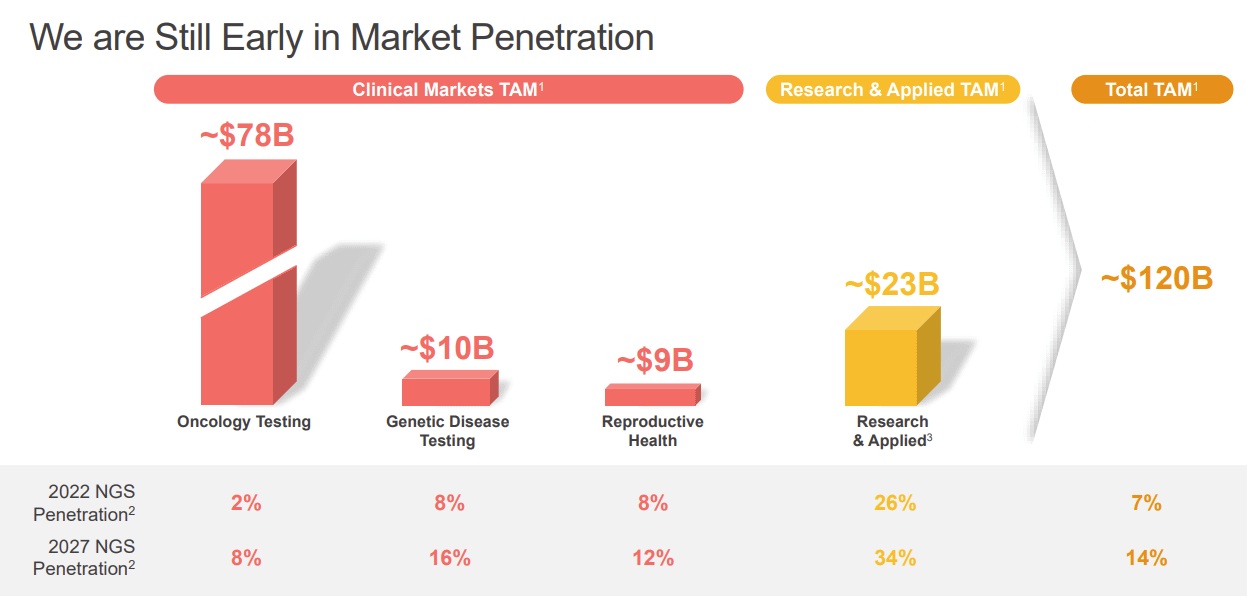
Creating New Markets
Because Ilumina is at the forefront of technological innovation, it has to directly contribute to creating new markets.
For example, Illumina provides low-cost assistance to pharmaceutical companies developing new treatments using NGS and outright sponsors clinical trials with partner hospitals.
Illumina offers training as well, either through online courses, at Illumina facilities, or through an instructor visiting the client’s facility.
This increase the attractiveness of genomics-based research, and makes it more likely that the FDA will approve new clinical use cases for NGS testing.
Illumina has 263 such collaborations ongoing, including many of the biggest pharmaceutical companies in the world.
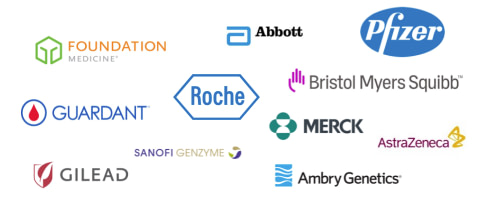
Illumina is also participating in massive, population-scale genomic analysis (with millions of people’s genomes sequenced at once).
This will create databases for researchers looking for new genetic causes of diseases, increasing the demand for testing in the long run.
The end goal is for everyone on earth to get full genome sequencing once in their life.
The new NovaSeq sequencer is a keystone of this clinical expansion strategy, as it is the first high-debit sequencer approved for In-Vitro Diagnostics (IVD).
The NovaSeq X, replacing the NovaSeq 6000, is the new Illumina flagship, expected to ramp up from 2023, with the first clinical application in 2024 and a growing base of clinical applications for 5 years after that. Illumina expects the demand for NovaSeq X to outstrip the supply in 2023.

This is not only looking to replace existing tests. The goal is to change how medicine is practiced.
NGS will allow for earlier detection of cancer or other health risks, increasing survival rates and reducing the need for intrusive treatment. This could happen very soon (more on that in the section below about Grail). And by helping to find one new type of treatment, NGS will create new therapeutic markets.
It should also allow for more efficient therapies, as it will point out what will and will not work based on the patient’s genetics.
Lastly, NGS will replace monitoring tests and make them cheaper and less intrusive (for example, a simple blood test replacing a complete scan).
6. Litigation & Financial Results
Is There a Problem?
I have been watching Illumina for a long time now, but for years its valuation was simply too pricey to make for a compelling investment. This became even more true during the pandemic when every medical and bio stock exploded upward. Illumina’s revenues jumped from $3.2B in 2020 to $4.5B in 2021.
Growth stocks slowed down post-pandemic, and this has not been good for Illumina’s stock price. Shares have dropped 60% from their 2021 peak, erasing all the pandemic gains and then some.
Revenue growth has also slowed, reaching “only” $4.7B TTM (Trailing Twelve Months).

Illumina’s CEO himself called the Q2 2022 performance “disappointing“, due to macroeconomic headwinds. Gross margins dropped slightly to 66% (still impressive), and R&D spending rose massively, from $202M to $327M.
| GAAP | Non-GAAP (a) | |||
|---|---|---|---|---|
| Dollars in millions, except per share amounts | Q2 2002 (b) | Q2 2021 | Q2 2022 (b) | Q2 2021 |
| Revenue | $ 1,162 | $ 1,126 | ||
| Gross margin | 66.0% | 71.2% | 69.4% | 71.8% |
| Research and development (“R&D”) expense | $ 327 | $ 202 | $ 327 | $ 202 |
| Selling, general and administrative (“SG&A”) expense | $ 410 | $ 413 | $ 339 | $ 269 |
| Legal contingencies | $ 609 | $ – | $ – | $ – |
| Operating (loss) profit | $ (579) | $ 187 | $ 141 | $ 338 |
| Operating margin | (49.8)% | 16.6% | 12.2% | 30.0% |
| Net (loss) income | $ (535) | $ 185 | $ 91 | $ 276 |
| Diluted (loss) earnings per share | $ (3.40) | $ 1.26 | $ 0.57 | $ 1.87 |
Source: Illumina Q2 2022
To add to these temporary issues, a charge of $609 million in legal contingencies has been put aside, leaving the company registering a loss for the first time in a decade.
Legal costs as high as half of the quarter revenue could be a big red flag, so let’s look at what happened.
Grail’s Botched M&A
Grail is a biotech company looking to develop an early cancer test using Illumina’s NGS technology. Being able to routinely check for cancer through a blood test (“liquid biopsy”) would be a true revolution, likely saving millions of lives every year.
Grail is currently enrolling participants in a truly massive clinical trial (1 million people), which could lead to the test being commercialized in 2 years.
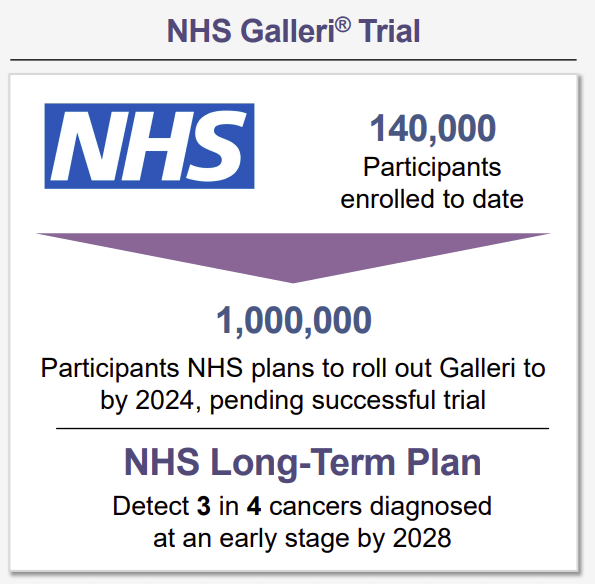
Grail’s history is rather complex. It was a spin-off from Illumina formed in 2016 as a separate company. It has since raised $2B, including from Jeff Bezos and Bill Gates. Illumina still held 14.5% of the Grail stocks.
Illumina then decided to buy back the whole of Grail, for the hefty sum of $9.7B.
The acquisition was offered half in cash and half in Illumina’s shares. I considered that a good option, and would even have welcomed a larger debt component, as Illumina has very little debt (total liabilities are just a little higher than its $2.9B in current assets).
Still, I have to question what went wrong, considering that Illumina should clearly have kept Grail in-house from the beginning, and financed its development alone.
It is possible that Illumina executives did not fully believe in the project at the time, moved to spread the risk, and were surprised by better-than-expected results.
This was the first mistake, a $7.7B mistake, or 1/4 of Illumina’s current valuation. Clearly, Illumina sees something in Grail’s results that make it want to buy out the other shareholders at almost any cost.
Such an acquisition can also create its own set of issues. Many of Illumina’s clients are developing competing products, and this could create conflicts of interest.
On top of this, the acquisition was challenged by anti-trust regulators on both sides of the Atlantic, mostly because of the risk of conflict of interest with other companies.
In the US, questions are coming from the FTC, which also blocked Illumina’s 2019 tentative to acquire its only real competitor, PacBio.
In the EU, the conflict escalated further, with the threat of a fine equal to 10% of the company’s global turnover.
Still, Illumina pressed on with the merger, “Regulators be damned” as commented in the industry press.
The expected 2024 FDA approval of Grail’s main test and a target of 50 million people tested (and a price tag per test of around $900-$1,000) is probably behind the rush. Even if spread over many years, this would be 10x Illumina’s current turnover.
In the long term, this mess with Grail should not have much impact on Illumina. It has still made for wasted money and negative headlines and it has hammered the stock price.
Option 1 is that the merger actually happens. This might make Illumina both an equipment and a very successful diagnostic company. It would be an expensive acquisition that could have been avoided, but will likely be a profitable one. Maybe a later IPO in 5 years or more could alleviate conflict of interest risk and still earn Illumina a large financial gain.
Option 2 is for the merger to be forced to unwind by EU and US regulators. Then Illumina will still own 14.5% of Grail, Grail will still run its test using Illumina machines, and Grail’s competitors will likely rely as well on Illumina’s best-in-class sequencers.
So overall, I expect this to be a temporary storm. It does not reflect very well on management’s strategic decisions, and this might be the worst aspect of the company.
But it is not as catastrophic as the recent stock price drop makes it appear. Legal costs are already covered now, so it should not affect future profitability.
Valuation
When drawing the last 10 years of Illumina’s performance on a graph, I stumble upon the issue of the last quarter’s loss (from acquisition costs and legal fees) which makes past growth not really readable. So I instead will show the revenue, net income, and cash flow until Q1 2022.
I think the growth profile of the company is still intact. Revenues are still in the same trend The only thing impacting free cash flow in the curve below is a 50% increase in R&D spending, something that should pay off in an even stronger long-term moat.
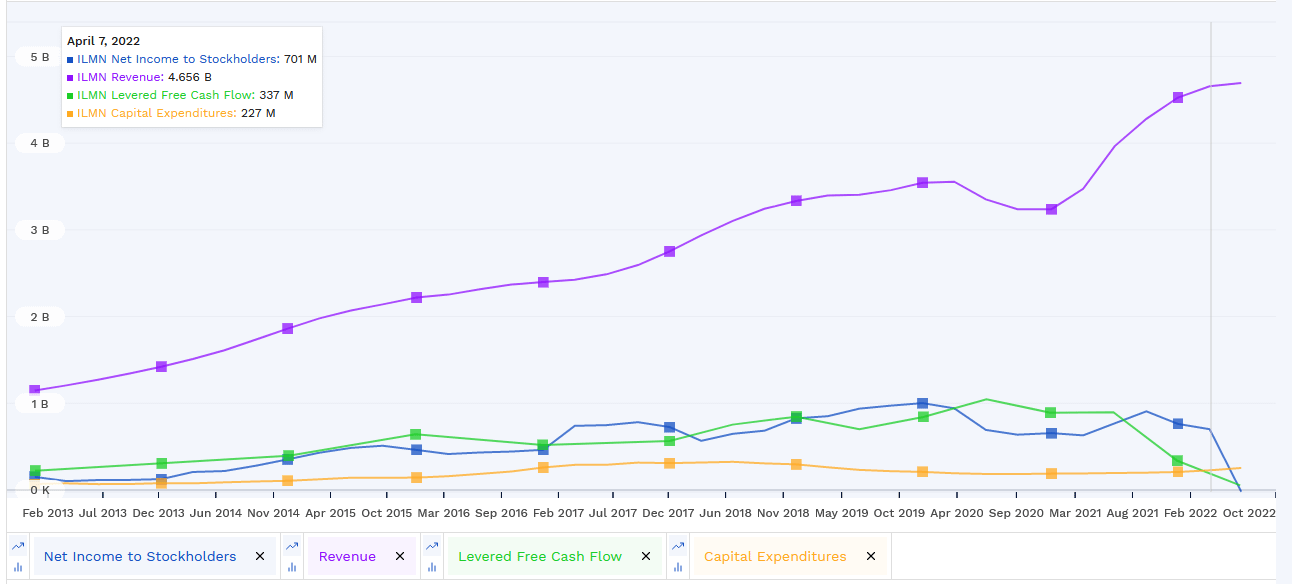
When it comes to valuation ratios, Illumina has been (justifiably in my opinion) valued at a high P/E between 40 and 130. Similarly high, price-to-sales oscillated from 6 to 20, and price-to-operating-cash-flow from 21 to 89.

The current price-to-sales ratio is 6.6. Earnings are negative so there’s no P/E. Same for free cash flow.
The current negative earnings and free cash flow are a direct result of the Grail acquisition costs and potential associated fines. At most, Grail will decrease total free cash flow while it gets ready for commercialization.
So this is mostly a one-time or short-term event that will not change the core moat and quality of Illumina.
With the price-to-sales ratio lower than in a decade, I think the stock is quite reasonably valued and potentially undervalued.
Returns to Shareholders
Illumina prefers share repurchases to dividends as a way to return capital to shareholders.
One on hand, considering the growth profile, this might be a good idea. On the other hand, considering the relatively high valuation of the company, I am not entirely convinced this is the ideal way to do it.
Illumina repurchased $750M worth of shares between February 2020 and now. With how expensive the share prices were at the time, I question the timing and capital allocation skill of Illumina’s management.
7. Conclusion
Illumina is a quasi-monopoly in a very fast-growing industry. Its growth is posed to accelerate steeply as new therapeutic applications are discovered.
The steady decline in genomics costs, paralleled only by the declining cost of semiconductor chips, opens new applications and directly increases the market size.
Illumina’s position is exceptionally strong. This is due to the flywheel of leading position, revenues, very high gross margin, and R&D spending. A very strong substitution cost moat helps as well.
Despite these advantages, the Grail acquisition creates a position that makes Illumina look like a broken growth story. The Company recently registered its first losses in a decade and its valuation multiples have fallen to the lowest point in 10 years.
Considering that Grail is a spin-off from Illumina and not a surprising new start-up, I question the company’s management strategic abilities. The whole mess and billions in costs could have been avoided 6 years ago by not spinning-off Grail in the first place.
Illumina still seems like a great way to benefit from the genomic revolution that will sweep healthcare in the decades to come. I fully stand by the Intel analogy in that respect.
So the question for a potential investor is not about the company’s quality. It is to decide whether or not to “forgive” the Grail blunder. Maybe Illumina’s management will have learned a lesson and will not repeat the mistake. Or not… Hard to tell really.
In any case, this is a stock to buy and hold for a long period of time. If the Grail disaster gets forgotten and Grail is integrated back, Illumina will return to its high multiple ratios valuation over time, and get extra support from steady growth.
In this bull case, the only moment I could imagine it makes sense to sell in less than 20 years would be a quasi-vertical run-up of the stock price equivalent to the heights of the dot-com bubble mania for Intel.
If the Grail acquisition fails, Ilumina will be more predictable and focused, even if probably a little less profitable in the long run.
Illumina would not be impervious to a global recession but have the balance sheet and margin to weather such a storm. So it might also make for a relatively defensive investment in trouble time.
Still, Grail news and a growing disaffection for growth stock could cause high volatility in the stock price in the short term.
Holdings Disclosure
Neither I nor anyone else associated with this website has a position in ILMN or plans to initiate any positions within 72 hours of this publication.
I wrote this article myself, and it expresses my own personal views and opinions. I am not receiving compensation from, nor do I have a business relationship with any company whose stock is mentioned in this article.
Legal Disclaimer
None of the writers or contributors of FinMasters are registered investment advisors, brokers/dealers, securities brokers, or financial planners. This article is being provided for informational and educational purposes only and on the condition that it will not form a primary basis for any investment decision.
The views about companies and their securities expressed in this article reflect the personal opinions of the individual analyst. They do not represent the opinions of Vertigo Studio SA (publishers of FinMasters) on whether to buy, sell or hold shares of any particular stock.
None of the information in our articles is intended as investment advice, as an offer or solicitation of an offer to buy or sell, or as a recommendation, endorsement, or sponsorship of any security, company, or fund. The information is general in nature and is not specific to you.
Vertigo Studio SA is not responsible and cannot be held liable for any investment decision made by you. Before using any article’s information to make an investment decision, you should seek the advice of a qualified and registered securities professional and undertake your own due diligence.
We did not receive compensation from any companies whose stock is mentioned here. No part of the writer’s compensation was, is, or will be directly or indirectly, related to the specific recommendations or views expressed in this article.























